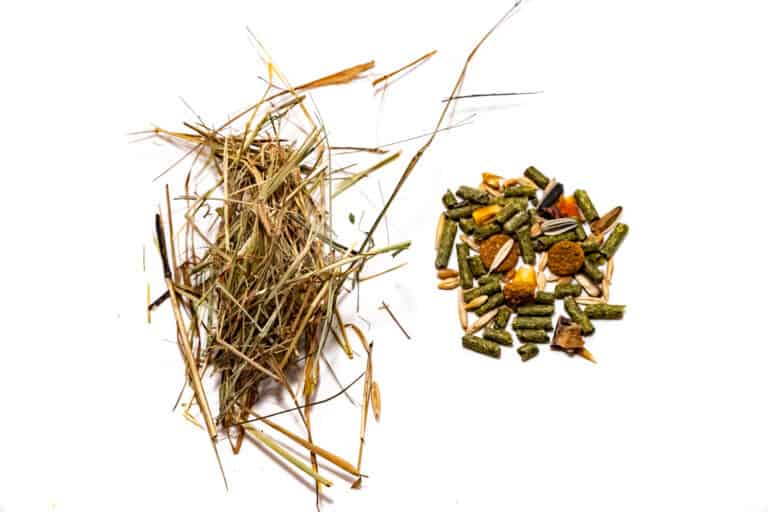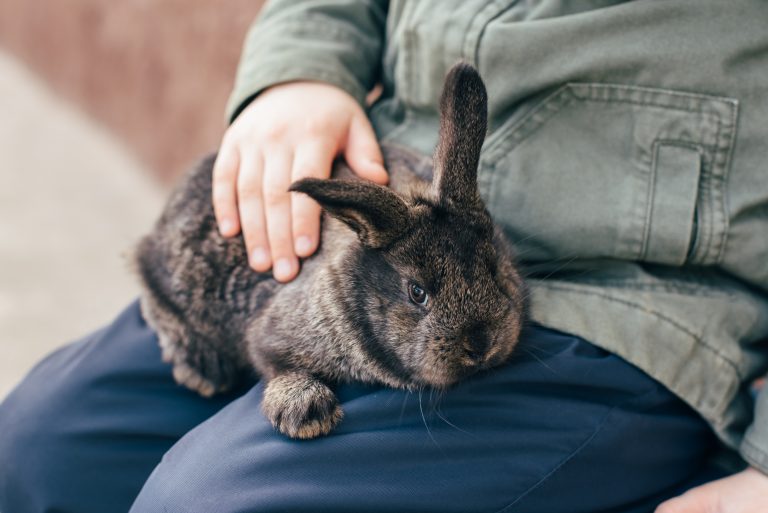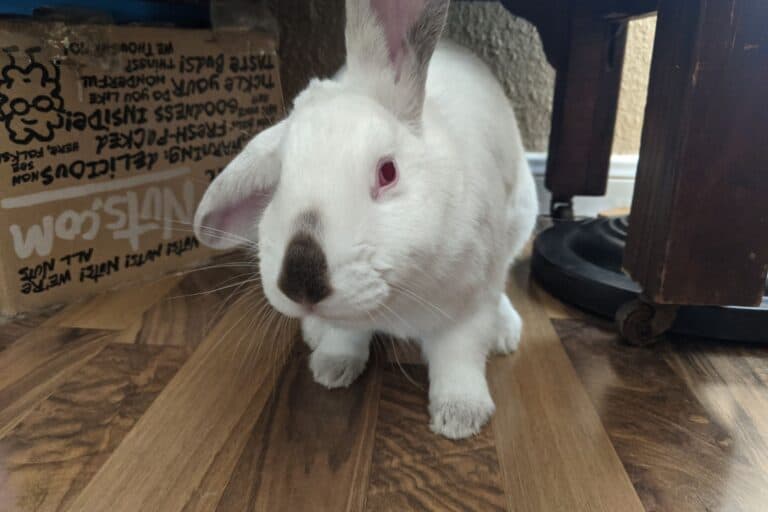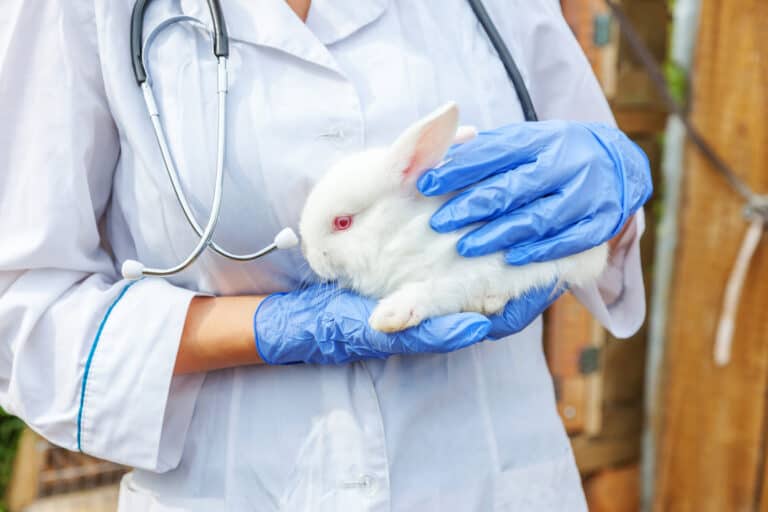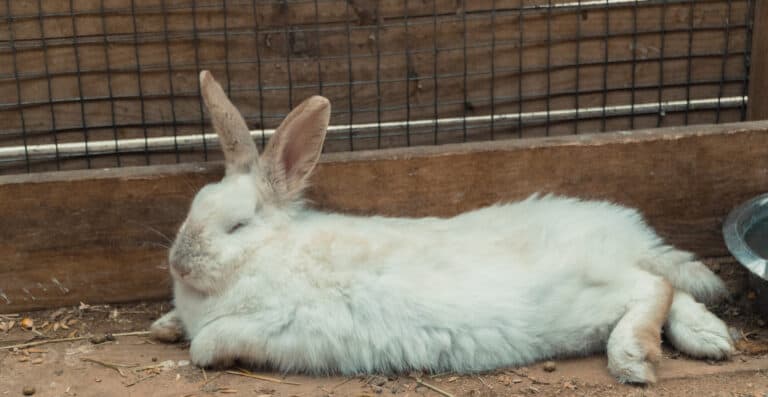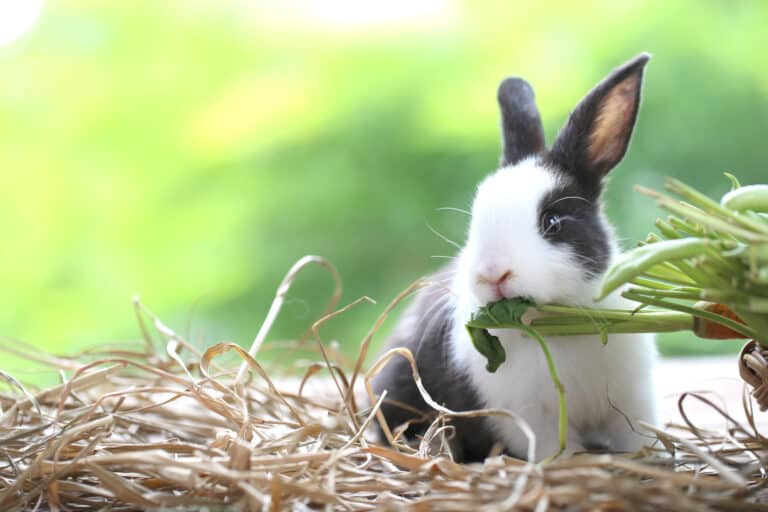How Long Can a Rabbit Go Without Food?
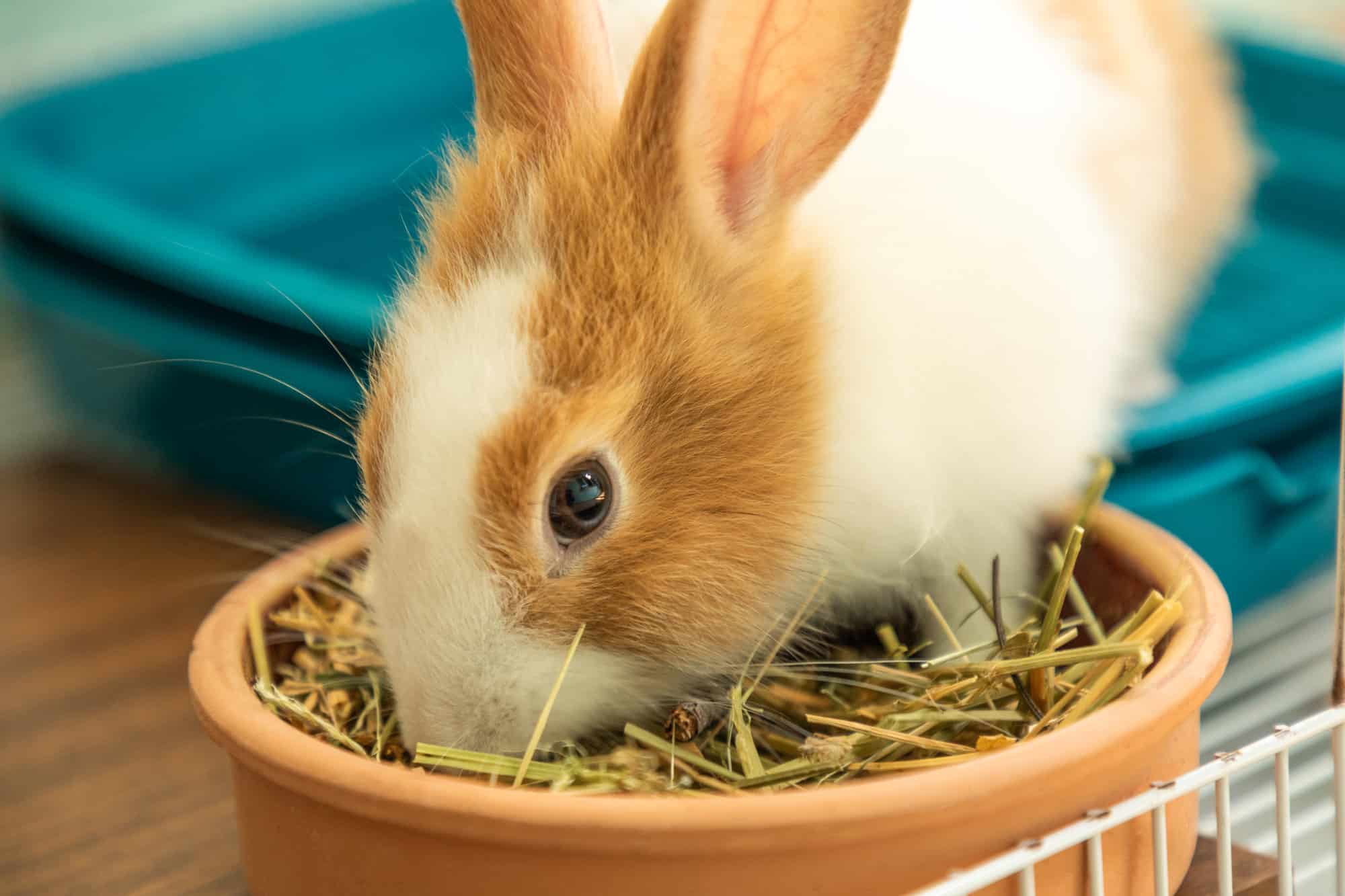
We know rabbits are cute and, oh, so lovable. That makes it very easy to fall in love with them. However, getting one on impulse is not a good idea, as keeping buns healthy and happy can be challenging. Some of the things you have to provide are shelter plus adequate food and water. You should also be ready to address certain issues, such as when your pet suddenly stops eating.
This leads us to the question of how long can rabbits go without food. Let’s see how much time you have before you start worrying about your fur baby’s condition.
How Long Can a Rabbit Go Without Food?
Some factors, such as your rabbit’s health and size, can affect how long he can survive without food. Healthy adult buns may live for up to 3 or 4 days without eating. Meanwhile, babies (kits) or senior, underweight ones may not make it through the day.
To be safe, you should never let your rabbit go without food for more than 12 hours. Otherwise, he may develop G.I. stasis, which, as we’ve mentioned, can be fatal. For the same reason, don’t let your bun go without drinking water for more than 24 hours.
A Rabbit’s Digestive System
A bun’s digestive system differs from other pets, such as cats and dogs. Rabbits are grazers, so they eat almost non-stop. The food goes to their intestines, which turns some of the smaller particles into cecotropes. The cecotropes are a particular type of poop rabbits eat. It may sound unpleasant, but the fecal material contains nutrients buns need.
The food rabbits eat goes readily through their system, and they also get the nutrients they need from their intake really quickly. Consequently, they should always have access to food and water to remain healthy.
How Much Should Rabbits Eat?
Rabbits should get a bundle of good-quality hay every day. The pile should be as big as they are. Make sure it’s fresh and available at all times. Avoid giving lawnmower clippings, as these can make your pet ill.
When it comes to veggies, provide a cup of vegetables for every 5 pounds of body weight. Choose at least 3 types for variety and make sure at least 1 is rich in Vitamin A. Romaine lettuce, parsley, carrot tops, and squash are examples of rabbit-safe veggies.
Offer fruits sparingly and only as treats. Most fruits have a high sugar content that can lead to weight gain and other health problems in rabbits.
If pellets are part of your pet’s meals, feed 25 grams per every kilogram of your bun’s weight. Don’t give muesli-type food, which can lead to tummy and dental issues.
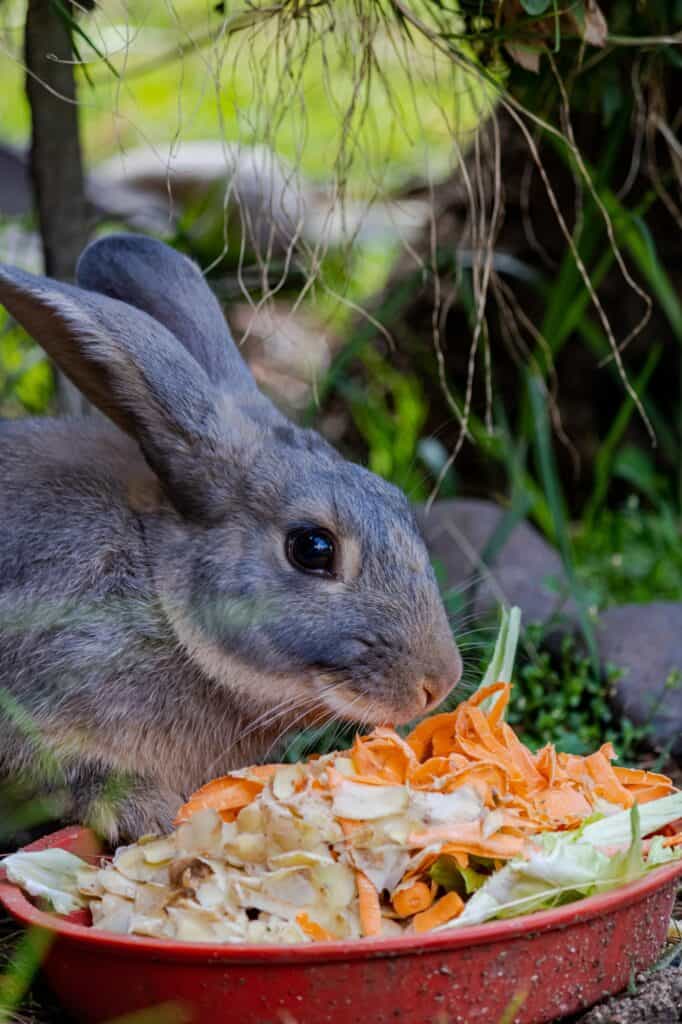
How Often?
As we said, rabbits are grazers. Unlike humans and other companion animals (dogs and cats), they eat throughout the day, not just at specific times. The food that enters their stomach keeps their gastrointestinal tract hydrated, thus allowing the food to move through their digestive system quickly. As such, they need access to food and water 24/7.
What Happens If They Stop Eating?
Your bun needs to eat constantly to keep his delicate digestive system functioning in top condition. If no food goes into his system for too long, he can develop a condition called Gastrointestinal stasis (G.I. stasis).
What is G.I. Stasis?
G.I. stasis is a condition where the movements of the digestive system slow down because of a lack of food. This leads to dehydration in the stomach, making stools harder and more difficult to pass.
Bacteria that break up the food can build up as a result. These bacteria release gas which accumulates in the stomach, causing pain that further reduces your bun’s appetite. Eventually, he may stop eating altogether, which can aggravate the situation.
G.I. stasis is a medical emergency. It can be resolved if you act quickly and take your fur baby to the vet. Left untreated, it could lead to serious consequences, even death.
Signs of G.I. Stasis
This potentially fatal condition is more likely to occur if your bun stops eating. When it does happen, you’ll see other signs of illness aside from your pet’s refusal to eat and drink. These include the following.
- Small, deformed, and loose droppings
- Bloating
- Hunched up posture
- Teeth grinding (this is a sign of pain in rabbits)
- Constipation
- Stops pooping altogether
- Does not want to be held or touched
What Can Cause Your Rabbit to Stop Eating?
If your bunny refuses to touch even his favorite treat, it may be because he’s ill or stressed. Some of the common reasons for your pet’s lack of appetite include the following:
- Dental diseases, such as gum or tooth infections or overgrown teeth
- Intestinal parasites
- Flea infestation
- Stress
- Pain
- Changes in diet

Signs Your Rabbit Isn’t Eating
Of course, you’ll easily notice your pet’s untouched food. But in some instances, he may not stop eating altogether. However, he may not be taking in enough food for optimum health. Here are some signs that your pet may be starving:
- Weak heartbeat
- Loss of body fat, muscle, and bone density
- Lethargy
- Runny or hard stools
- Reduced poop output
- Teeth grinding
- Caved-in stomach
How to Get Them to Eat
Your bun’s refusal to touch his food is not only frustrating for you, but it can also impact his health. As such, you’ll need to act quickly before he develops serious medical issues. You can try the following 6 tips and see if they will encourage your rabbit to eat:
1. Try Giving New Food
Hay is a vital component of your bun’s diet, so you’ll want him to keep eating this food. If he won’t even look at his serving of hay, try other types. For example, if you usually feed him Timothy Hay, see if you can revive his appetite by serving orchard, brome, or oat hay.
The other types may be more appetizing to him, so he’ll be more likely to munch on them. Don’t give alfalfa hay, though, as its high protein and calcium content isn’t good for adult rabbits.
2. Use a Different Type of Hay Rack
Sometimes, certain health conditions make it difficult for your bun to eat in his usual position. So try to give your pet some options. If he’s used to a hay rack that sits close to the ground, try one that hangs on the side of his cage.
3. Reverse Whatever Changes You Made to Your Rabbit’s Diet
Some buns refuse to eat because they don’t like the changes in their diet. Try going back to what you usually feed him. Alternatively, see if you can entice him to eat the new food by mixing the original food with the new one.
4. Syringe Feed Your Rabbit
Syringe feeding can stimulate your fur baby’s appetite. Critical Care (prescribed by a vet) gets much needed nutrients into your rabbit. He or she may eventually take a nibble and decide that he’s hungry after all. Keep a pile of fresh hay in his cage in case he resumes feeding normally.
5. Offer Smaller Portions
Blend some of your pet’s favorite food with his hay. However, give only small portions so the food doesn’t go stale, making it more unappealing to your rabbit.
6. Contact Your Vet
If all else fails, a trip to the vet is the next step, especially if your bun won’t touch even those foods he loves. The vet will examine your rabbit to pinpoint the cause of his appetite loss and address whatever health issues your rabbit may have.
Rabbits are companion animals like cats and dogs. However, their care differs from your other fur babies. How long can a rabbit go without food depends on a few factors. But in general, a rabbit shouldn’t stop feeding for more than 12 hours. Otherwise, he may develop serious health conditions. If your bun refuses to eat, do your best to stimulate his appetite. If that fails, reach out to your vet as soon as possible.
More About Rabbit Diet!
- Is Orchard Hay Good for Rabbits?
- The Best Lettuce for Rabbits: What Type Can They Eat
- Complete Guide to the Best Hay For Rabbits: Reviews & More
- What Can You Feed Wild Rabbits: A Comprehensive Guide
- Can Rabbits Have Cabbage? What You Need to Know!
We hope you enjoyed this post! If you did, will you give it a share or two 🙂 Thank you! ~from Every Bunny Welcome


